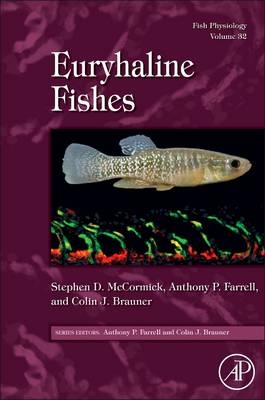
Fish Physiology: Euryhaline Fishes
Academic Press Inc (Verlag)
978-0-12-396951-4 (ISBN)
The need for ion and water homeostasis is common to all life. For fish, ion and water homeostasis is an especially important challenge because they live in direct contact with water and because of the large variation in the salt content of natural waters (varying by over 5 orders of magnitude). Most fish are stenohaline and are unable to move between freshwater and seawater. Remarkably, some fishes are capable of life in both freshwater and seawater. These euryhaline fishes constitute an estimated 3 to 5% of all fish species. Euryhaline fishes represent some of the most iconic and interesting of all fish species, from salmon and sturgeon that make epic migrations to intertidal mudskippers that contend with daily salinity changes. With the advent of global climate change and increasing sea levels, understanding the environmental physiology of euryhaline species is critical for environmental management and any mitigative measures. This volume will provide the first integrative review of euryhalinity in fish. There is no other book that focuses on fish that have the capacity to move between freshwater and seawater. The different challenges of salt and water balance in different habitats have led to different physiological controls and regulation, which heretofore has not been reviewed in a single volume.
Dr. Colin Brauner was educated in Canada at the University of British Columbia (Ph D), followed by a Post-doctoral fellowship at Aarhus University and the University of Southern Denmark, and was a Research Associate at McMaster University. He is a Professor of Zoology, UBC and Director of the UBC Aquatics Facility. He has been a Co-Editor of the Fish Physiology series since 2006. His research investigates environmental adaptations (both mechanistic and evolutionary) in relation to gas-exchange, acid-base balance and ion regulation in fish, integrating responses from the molecular, cellular and organismal level. The ultimate goal is to understand how evolutionary pressures have shaped physiological systems among vertebrates and to determine the degree to which physiological systems can adapt/acclimate to natural and anthropogenic environmental changes. This information is crucial for basic biology and understanding the diversity of biological systems, but much of his research conducted to date can also be applied to issues of aquaculture, toxicology and water quality criteria development, as well as fisheries management. His achievements have been recognized by the Society for Experimental Biology, UK (President’s medal) and the Canadian Conference for Fisheries Research (J.C. Stevenson Memorial Lecturer) and the Vancouver Marine Sciences Centre (Murray A. Newman Award for Aquatic Research). He is a former President of the Canadian Society of Zoologists.
1. Principles and patterns of osmoregulation and euryhalinity in fish
Sue Edwards
2. Osmosensing and autoregulation of euryhalinity
Dietmar Kueltz
3. Hormonal Control of euryhalinity
Yosio Takei and Stephen D. McCormick
4. Euryhaline Elasmobranchs
James S. Ballantyne and David I. Fraser
5. Smolt Physiology: the freshwater-seawater transitions in salmonids
Stephen D. McCormick
6. Freshwater-Seawater transitions in migratory fish
Joseph Zydlewski
7. Seawater-Freshwater transitions in migratory fish
J. Mark Shrimpton
8. Euryhalinity: Intertidal fish
William Marshall
9. Euryhalinity: extreme environments
Colin Brauner and Jonathan Wilson
10. Evolution of euryhalinity
Eric Schultz and Stephen D. McCormick
| Reihe/Serie | Fish Physiology |
|---|---|
| Verlagsort | San Diego |
| Sprache | englisch |
| Maße | 152 x 229 mm |
| Gewicht | 1070 g |
| Themenwelt | Naturwissenschaften ► Biologie ► Limnologie / Meeresbiologie |
| Naturwissenschaften ► Biologie ► Zoologie | |
| ISBN-10 | 0-12-396951-4 / 0123969514 |
| ISBN-13 | 978-0-12-396951-4 / 9780123969514 |
| Zustand | Neuware |
| Haben Sie eine Frage zum Produkt? |
aus dem Bereich


